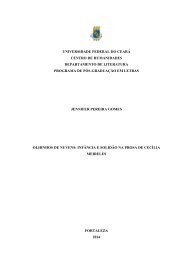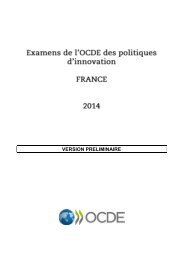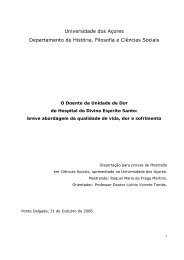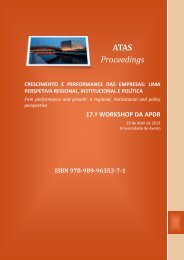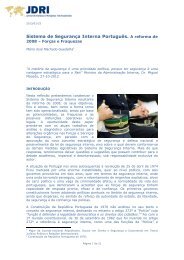1POTXAdSn
1POTXAdSn
1POTXAdSn
You also want an ePaper? Increase the reach of your titles
YUMPU automatically turns print PDFs into web optimized ePapers that Google loves.
dominantes de oeste, nenhuma das espécies que nidificam<br />
regularmente na região é de origem Neárctica.<br />
Das espécies que nidificam de forma regular, destaca-se<br />
o Priolo Pyrrhula murina, único passeriforme<br />
endémico dos Açores e uma das espécies mais ameaçadas<br />
da Europa que nidifica na floresta de Laurissilva da<br />
parte leste da ilha de São Miguel, e o painho-das-tempestades-de-monteiro<br />
Oceanodroma monteiroi, única<br />
ave marinha endémica dos Açores que nidifica somente<br />
em dois pequenos ilhéus da ilha da Graciosa (Ramos<br />
1994; Heath & Evans 2000; Bolton et al. 2008).<br />
As restantes populações de aves marinhas estão entre<br />
as mais importantes da Europa. Nos Açores ocorre<br />
a maior população de cagarro (Calonectris diomedea<br />
borealis) no mundo. Apesar da espécie não ser considerada<br />
ameaçada a nível mundial (BirdLife International<br />
2009), a população restringe-se ao Atlântico<br />
subtropical nordeste e ao Mediterrâneo. Também importantes<br />
são as concentrações de painho-da-madeira<br />
Oceanodroma castro e de frulho Puffinus baroli.<br />
Ocorre ainda uma pequena população de estapagado<br />
Puffinus puffinus que nidifica nas ilhas do grupo ocidental,<br />
uma população residual de alma-negra Bulweria<br />
bulwerii em Santa Maria e já foram capturados<br />
indivíduos de uma das espécies mais ameaçadas na<br />
Europa, a freira-do-bugio Pterodroma feae (Monteiro<br />
et al. 1996). De acordo com as crónicas de Gaspar<br />
Frutuoso, é provável que esta espécie tenha nidificado<br />
outrora nos Açores.<br />
Nos Açores nidificam ainda duas espécies que,<br />
embora sejam relativamente comuns a nível mundial,<br />
constituem importantes populações a nível europeu<br />
e nacional, respectivamente, o garajau-rosado<br />
Sterna dougallii, e o garajau-comum Sterna hirundo<br />
(Gochfeld 1983, Del Nevo et al. 1993, BirdLife International<br />
2004).<br />
Ocorrem ainda o canário-da-terra Serinus canaria,<br />
passeriforme que nidifica somente nas ilhas da<br />
Macaronésia, e uma série de subespécies endémicas<br />
de passeriformes, à semelhança da situação verificada<br />
na maioria dos sistemas insulares, das quais se destacam<br />
em primeiro lugar a estrelinha Regulus regulus<br />
com três subespécies (R. r. azoricus, R. r. inermis e<br />
R. r. sanctaemariae), e também a alvéola Motacilla<br />
cinerea patriciae, o melro-negro Turdus merula azorensis,<br />
a toutinegra-de-barrete Sylvia atricapilla gula-<br />
256<br />
prevailing westerly winds, none of the species that<br />
breed in the Azores has a Nearctic origin.<br />
Among the regular breeding species, we must<br />
emphasize the Azores bullfinch Pyrrhula murina,<br />
the only Azorean endemic passerine and one of the<br />
most threatened European species, which nests in the<br />
Laurissilva in the eastern part of São Miguel island,<br />
and Monteiro’s storm-petrel Oceanodroma monteiroi,<br />
the only Azores endemic seabird, which nests only<br />
on two small islets of Graciosa Island (Ramos 1994;<br />
Heath & Evans 2000; Bolton et al. 2008).<br />
The remaining populations of marine birds are<br />
among the most important in Europe. The Azores<br />
harbour the largest population of Cory’s shearwaters<br />
(Calonectris diomedea borealis) in the world. Although<br />
this species in not considered globally threatened<br />
(BirdLife International 2009), its distribution is<br />
restricted to the subtropical north-eastern Atlantic<br />
and the Mediterranean. The concentrations of bandrumped<br />
storm-petrels Oceanodroma castro and Little<br />
(or Macaronesian) shearwaters Puffinus baroli in the<br />
Azores are also important. The archipelago also holds a<br />
small population of Manx shearwaters Puffinus puffinus<br />
on the islands of the Western Group, and a residual<br />
population of Bulwer´s petrels Bulweria bulwerii on<br />
Santa Maria. Individuals of one of the most threatened<br />
European species, Fea’s petrel Pterodroma feae, have<br />
also been captured in the Azores (Monteiro et al.<br />
1996). According to Gaspar Frutuoso’s chronicles, this<br />
species was likely to breed in the Azores in the past.<br />
The Azorean populations of two other seabird<br />
species, namely the roseate tern Sterna dougallii and<br />
the common tern Sterna hirundo, represent a large<br />
part of the European and Portuguese populations,<br />
respectively, even though both species are relatively<br />
common at the world’s scale (Gochfeld 1983; Del<br />
Nevo et al. 1993, BirdLife International 2004).<br />
The Azores also hold the canary Serinus canaria,<br />
a passerine endemic to Macaronesia, and several<br />
endemic subspecies of Passeriformes, similarly to<br />
what happens in the majority of insular systems. The<br />
endemic passerines include three subspecies of the<br />
goldcrest Regulus regulus (R. r. azoricus, R. r. inermis<br />
and R. r. sanctaemariae), and also one subspecies of the<br />
grey wagtail Motacilla cinerea patriciae, the common<br />
blackbird Turdus merula azorensis, the blackcap Sylvia






